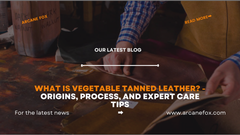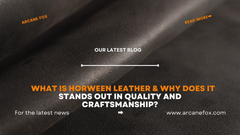What is Kangaroo Leather? & It’s Strength, Production, and Uses

What is Kangaroo Leather? & It’s Strength, Production, and Uses
Choosing the right leather for a project can make all the difference in the final result. Kangaroo leather stands out with its unique qualities, making it ideal for specific types of work.
Kangaroo leather is crafted from the skin of kangaroos, a marsupial native to Australia. It is renowned for being one of the strongest types of leather available, thanks to the distinctive structure of the collagen fibers in their skin. This exceptional strength makes kangaroo leather a popular choice for motorbike clothing, upholstery, cleats, and whips.
Given its remarkable strength and versatility, let's delve deeper into how kangaroo leather is produced and explore its various uses in leatherworking projects and more.
1. What is Kangaroo Leather?

Kangaroo leather is made from kangaroo skins. It is a marsupial animal that is indigenous to Australia. There are farms home to over 35 million kangaroos, which can weigh 200 pounds apiece. Australia's national symbol is the kangaroo as well.
The majority of the multiple kangaroo species are exempt from hunting restrictions under Australian national law. On the other hand, a few species are more widespread, and plentiful, and permit license-holder hunting. Some would argue that this helps keep the population under control. Some argue that it may not be required.
Hunters generally process kangaroos for their skins and food. They make the skins into kangaroo leather while people consume the meat in Australia and other countries. Numerous products, such as shoes, boots, whips, gloves, upholstery, cleats, and motorcycle clothes, include kangaroo leather. The leather industry values it for its distinct strength.
2. How is Kangaroo Leather Made?
Kangaroo leather production involves several meticulous steps to ensure high quality. The process begins with the ethical harvesting of kangaroos, followed by the careful preparation of their hides.
- Harvesting: Licensed hunters collect kangaroo hides, ensuring sustainable practices to maintain ecological balance. These hides are then transported to processing facilities.
- Curing: The hides undergo curing to prevent decay. This process involves salting or refrigerating the skins to preserve them until further processing.
- Soaking and Liming: The cured hides are soaked in water to remove salt and dirt. They are then treate with a lime solution to loosen hair and other impurities.
- Fleshing: Remove any remaining flesh and fat from the hides to ensure a clean surface for tanning.
- Tanning: The hides are soaked in tanning solutions, typically involving chrome tanning for this leather. This process stabilizes the collagen fibers, making the leather durable and resistant to decay.
- Drying and Conditioning: Carefully dry and condition the tanned leather to achieve the desired flexibility and softness.
- Finishing: The final step involves dyeing, embossing, and applying protective coatings to enhance the leather’s appearance and durability. This finishing process ensures the leather meets industry standards for various applications.
These steps transform raw kangaroo hides into premium leather, renowned for its strength, lightweight, and exceptional quality, suitable for a wide range of products.
3. Why is Kangaroo Leather so Strong?

Because of the way the skin's collagen fibers are structured, kangaroo leather is incredibly durable. In contrast to cows, sheep, or other animals, kangaroos lack sweat glands in their skin. As a result, the skin's structure can be considerably more uniform and constant.
Furthermore, the collagen fiber structure primarily aligns with the skin's surface. This aids in the formation of a thick, even pattern across the skin. While the hides of other animals vary somewhat, kangaroo leather is largely uniform.
This leather's skin structure also makes it possible to divide it into thinner pieces while maintaining a significant amount of its strength. For instance, a split cow leather hide with 20% of its original thickness still has 2% of its previous strength on average. An average of 50% of the original strength is retained by a split kangaroo leather skin that is 20% thicker than before. Incredible.
The differences in leather strength are due mainly to the skin’s structure. There are various layers of cow leather, each with a different composition, collagen density, and fiber alignment. There are several weak spots in the overall structure when it is cut.
Because kangaroo leather is uniform throughout, most of its strength holds up even after it is sliced. As we would observe in most materials, the primary cause of the strength loss is simply a decrease in material thickness (for example thicker cotton or thinner cotton). Moreover, this leather is sturdy and functional even in thin parts. Because of its uniformity, it can also be use for goods that call for strong, long-lasting leather.
4. What is Kangaroo Leather Used for?

Kangaroo leather is used in a wide range of applications that demand tough, dense leather. Protective gear and products for motorcyclists are common applications. Riders must have protective gear in case they fall. They frequently don a blazer and leather pants. Compared to other types of leather, this type's density and strength allow it to better endure abrasion across concrete.
Additionally, this type of leather is used in the production of boots and shoes. Strong leather improves the products' appearance, performance, and longevity by resisting wear, abrasion, and scuffs. For instance, it's use to make football and soccer cleats.
A common application for kangaroo leather is the production of whips. Whips require strong leather because they are long, thin pieces of leather—some of them are even several feet long. The preferred leather maintains its uniform strength even when sliced into long, thin costs.
People also use kangaroo leather to make small leather products and accessories. Personal preference can influence the final product's look and material choice. One leather to consider when choosing for a project is a kangaroo.
5. Kangaroo Leather Boots/Kangaroo Leather Cleats

Don't overlook kangaroo leather boots, one of the main applications for this material. Players wear these shoes, also known as kangaroo leather cleats, on the soccer (football) pitch.
The solid, sturdy surface of the firm-yet-flexible cleats allows for reliable foot strikes against the ball. K-leather is a common term used to describe kangaroo leather used for cleats. While some athletes still favor real leather, others have switched to synthetic leather for their cleats.
6. Annual Production Volume of Kangaroo Leather
Every year, over 1-3 million kangaroos are processed for food and leather. Compared to the amount of leather produced worldwide from cattle, sheep, or goats, this is negligible.
However, there is a specialized worldwide market for kangaroo leather. While restricted by Australian legislation to permissible hunting and harvesting, these figures are subject to annual variation dependent on allowed restrictions and animal population.
Experts estimate the value of kangaroo exports to be $133 million, with $10 million coming from the sale of kangaroo leather. Every year, over 60 countries import kangaroo meat, which people regard as having very little fat.
7. Pros And Cons of Kangaroo Leather
|
Pros |
Cons |
|
Strength and Durability: Extremely robust and long-lasting. |
Ethical Concerns: Issues related to animal welfare. |
|
Lightweight: Lighter than many other leathers, ideal for athletic gear. |
Grain and Creases: Noticeable grain and prone to creasing. |
|
Abrasion Resistance: Highly resistant to wear and tear. |
Limited Availability: Not as widely available as other leathers. |
|
Breathability: Can be split thin while maintaining strength. |
Expensive: High-quality products can be costly. |
|
Sustainability: Regulated hunting practices make it sustainable. |
Matte Texture: Develops a patina and darkens quickly. |
|
Flexibility: Soft and flexible despite its strength. |
Allergies: Potential for allergic reactions. |
|
Unique Appearance: Natural grain pattern adds aesthetic appeal. |
Cultural Sensitivity: This may be seen as insensitive in some cultures. |
|
Tailor-Made Fit: Cleats mold quickly to the wearer’s foot. |
California Ban: Banned in California due to conservation concerns. |
|
High Strength-to-Weight Ratio: Strong yet lightweight. |
Wildlife Impact: Mismanagement can harm ecosystems. |
|
Low-Fat Content: Consistent and strong without weak spots. |
8. Kangaroo Leather Care & Maintenance

All leather, including kangaroo leather, will gain from appropriate upkeep and care. If leather is properly cleaned, conditioned, and stored, it will function well and survive for many years.
To be sure the cleanser or finish you're using won't react negatively with the material, test any stage of leather care on a small area first. After you're sure it's safe, tidy up
8.1 How to Clean Kangaroo Leather?
To clean kangaroo leather, wet a lint-free towel and gently massage it over the dirty area. For this, microfiber cloths are useful. Use a specific leather cleaner if the dirt is deeply embedded or if you want to thoroughly clean the leather.
These cleaners are designe to remove dirt, dust, and filth without harming the leather. They also typically do a good job of preparing the surface for a conditioner and, if needed, a finish.
8.2 How to Condition Kangaroo Leather?
Condition kangaroo leather the same way as most other leathers. Use an applicator or soft cloth to apply the conditioner after thoroughly cleaning the surface. Typically, apply the conditioner in tiny circles, let it absorb, and then remove any excess with a fresh cloth.
Leather dressings, oils, lotions, and specialty mixtures are examples of this leather conditioners. The leather is prepare for a polish or protective coat, if preferred, after conditioning.
8.3 How to Make Kangaroo Leather Water Resistant?
To make this leather more water-resistant, apply a wax protectant. Fully coat the cleaned and conditioned leather with wax. Usually, remove the wax after a few minutes, leaving the leather with a smooth, pleasing shine. This process also provides a barrier that aids in water resistance.
8.4 How to Store Kangaroo Leather?
Kangaroo leather needs to be kept in a cold, dry, and dust-free environment. In general, conditions with low average humidity are beneficial for leather items. Additionally advantageous is airflow, which lets the leather's inherent fibers "breathe."
If stored in a sealed space, the humidity may build up, causing the leather to begin to degrade and grow mold. Low humidity can cause leather to dry out, which may weaken and split the fibers.
A closet or dressing room with regular circulation, a comfortable humidity level, and an average temperature are suitable places to store kangaroo leather.
The kangaroo's resilience and tenacity make it stand out. When you are thinking about what to use for your next project, it is something to keep in mind.
9. Moving Forwards
Kangaroo leather offers a unique blend of strength, flexibility, and durability that sets it apart from other types of leather. Its distinct properties make it an excellent choice for a variety of applications, from high-performance sports gear to luxury fashion items. While there are ethical considerations to keep in mind, the regulated and sustainable practices in place ensure that kangaroo leather can be a responsible choice for those seeking premium materials.
Whether you're crafting motorbike items, designing footwear, or creating durable accessories, kangaroo leather provides unparalleled performance and longevity. Moreover, Embrace the exceptional qualities of this extraordinary leather in your next project and experience the difference that kangaroo leather can make.
Related Posts:
- What is Cowhide Leather? Origins, Types, and Maintenance
- What is Goatskin Leather? Different Types of Goatskin, Quality, Durability and More
- What is Sheepskin Leather? Everything You Need To Know
- What is Lambskin Leather? The Ultimate Guide on Quality, Durability and More
- What is Exotic Leather? Origins, Types, Care, and more
- What is Calfskin Leather? It's Quality & Durability Against Other Leather!
- What is Buffalo Leather? - It’s Uses, Care, and Comparison with Other Leather
- What is Horse Leather? - It's Durability, Uses, and Caring Tips





